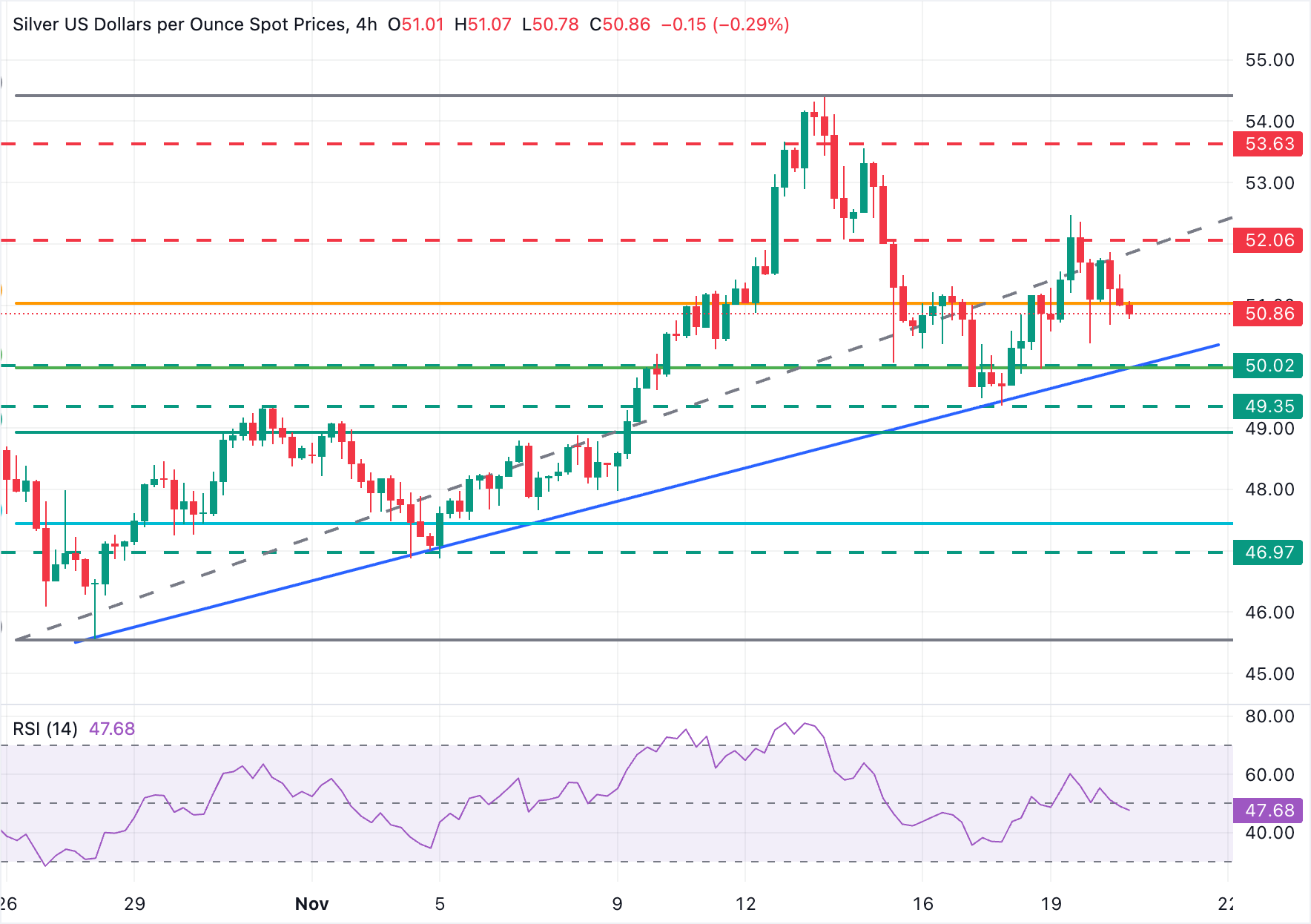Silver Price Forecast: XAG/USD hesitates around $51.00 with US NFP eyed
- Silver wavers around $51.00 after rejection at $52.00 on Wednesday.
- Dwindling hopes of a Fed interest rate cut in December are boosting the US Dollar.
- XAG/USD’s broader bias remains positive as long as it remains above $50.00.
Silver (XAG/USD) retreated from weekly highs near $52.00 on Wednesday, as the US Dollar jumped following the release of hawkishly leaning FOMC minutes. The precious metal is now hesitating around the $51.00 level, although it maintains its broader bullish trend intact, while above the $50.00 area.
The Fed cut rates by 25 basis points in December, but the minutes of the meeting, released on Wednesday, showed a significant opposition within the committee. This has prompted investors to dial down hopes of another interest rate cut in December, which sent the Greenback rallying across the board.
XAU/USD has a strong support area at $50.00

The technical picture shows hesitation, with price action moving within Wednesday’s trading range, with upside attempts capped below a previous support area, at $52.00 (November 13 lows), and bears contained above the key $50.00 area.
The long wicks in the daily chart reveal an undecided market. To the downside, bears should confirm the break of a confluence of support levels in the area of $50.00, where Wednesday’s low meets the 50% Fibonacci retracement of the early November rally and the rising trendline from late October lows.
Further down, the October 13 high, and November 18 low, at $49.35 would come into focus, ahead of the 61.8% Fibonacci retracement of the mentioned cycle, near $48.90.
Bulls, on the contrary, would have to break above the mentioned $52.00 area to shift the focus towards the November 14 high at $53.65 and the long-term highs between $54.60 and $54.80.
Silver FAQs
Silver is a precious metal highly traded among investors. It has been historically used as a store of value and a medium of exchange. Although less popular than Gold, traders may turn to Silver to diversify their investment portfolio, for its intrinsic value or as a potential hedge during high-inflation periods. Investors can buy physical Silver, in coins or in bars, or trade it through vehicles such as Exchange Traded Funds, which track its price on international markets.
Silver prices can move due to a wide range of factors. Geopolitical instability or fears of a deep recession can make Silver price escalate due to its safe-haven status, although to a lesser extent than Gold's. As a yieldless asset, Silver tends to rise with lower interest rates. Its moves also depend on how the US Dollar (USD) behaves as the asset is priced in dollars (XAG/USD). A strong Dollar tends to keep the price of Silver at bay, whereas a weaker Dollar is likely to propel prices up. Other factors such as investment demand, mining supply – Silver is much more abundant than Gold – and recycling rates can also affect prices.
Silver is widely used in industry, particularly in sectors such as electronics or solar energy, as it has one of the highest electric conductivity of all metals – more than Copper and Gold. A surge in demand can increase prices, while a decline tends to lower them. Dynamics in the US, Chinese and Indian economies can also contribute to price swings: for the US and particularly China, their big industrial sectors use Silver in various processes; in India, consumers’ demand for the precious metal for jewellery also plays a key role in setting prices.
Silver prices tend to follow Gold's moves. When Gold prices rise, Silver typically follows suit, as their status as safe-haven assets is similar. The Gold/Silver ratio, which shows the number of ounces of Silver needed to equal the value of one ounce of Gold, may help to determine the relative valuation between both metals. Some investors may consider a high ratio as an indicator that Silver is undervalued, or Gold is overvalued. On the contrary, a low ratio might suggest that Gold is undervalued relative to Silver.
